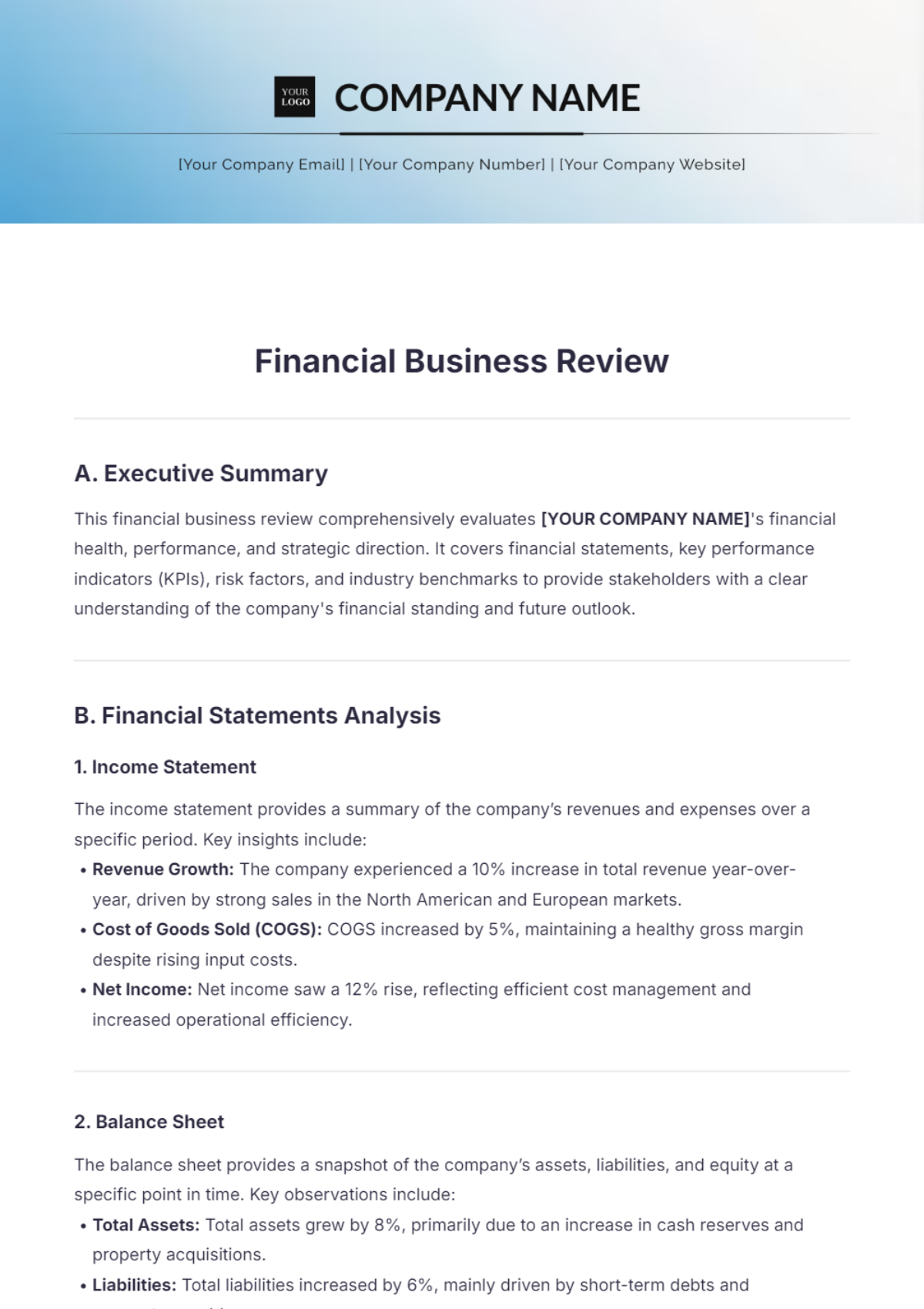Free Financial Business Review

A. Executive Summary
This financial business review comprehensively evaluates [YOUR COMPANY NAME]'s financial health, performance, and strategic direction. It covers financial statements, key performance indicators (KPIs), risk factors, and industry benchmarks to provide stakeholders with a clear understanding of the company's financial standing and future outlook.
B. Financial Statements Analysis
1. Income Statement
The income statement provides a summary of the company’s revenues and expenses over a specific period. Key insights include:
Revenue Growth: The company experienced a 10% increase in total revenue year-over-year, driven by strong sales in the North American and European markets.
Cost of Goods Sold (COGS): COGS increased by 5%, maintaining a healthy gross margin despite rising input costs.
Net Income: Net income saw a 12% rise, reflecting efficient cost management and increased operational efficiency.
2. Balance Sheet
The balance sheet provides a snapshot of the company’s assets, liabilities, and equity at a specific point in time. Key observations include:
Total Assets: Total assets grew by 8%, primarily due to an increase in cash reserves and property acquisitions.
Liabilities: Total liabilities increased by 6%, mainly driven by short-term debts and accounts payable.
Shareholders' Equity: Equity improved by 10%, highlighting retained earnings and capital investments.
3. Cash Flow Statement
The cash flow statement illustrates the company’s cash inflows and outflows during the period. Notable points include:
Operating Cash Flow: Positive cash flow from operations due to higher revenue collection and prudent expense management.
Investing Activities: Increased spending on capital expenditures and strategic investments in technology.
Financing Activities: Reduction in debt through regular repayments and minimal new borrowing.
C. Key Performance Indicators (KPIs)
The following KPIs are critical in assessing the company’s financial performance:
Return on Investment (ROI): Indicated a 15% return, showcasing effective resource allocation and profitability.
Debt to Equity Ratio: A moderate ratio of 0.5, reflecting a balanced approach to leveraging debt for growth.
Current Ratio: Stood at 1.8, demonstrating sufficient liquidity to cover short-term liabilities.
D. Risk Factors
Several risk factors were identified that could impact financial performance:
Market Risk: Exposure to economic downturns and market volatility may affect sales and revenue.
Credit Risk: Risk associated with customers' inability to pay for goods and services on time.
Operational Risk: Potential disruptions in supply chain and production processes.
E. Industry Benchmarks
Comparing the company’s performance to industry peers reveals:
Revenue Growth Rate: The company’s growth rate exceeds the industry average by 3%.
Profit Margins: Maintained margins on par with top industry players, reflecting competitive pricing and cost control.
Market Share: Gained a modest market share increase due to expansion into emerging markets.
F. Conclusion
In conclusion, the financial business review indicates that [YOUR COMPANY NAME] is on a solid financial footing with strong revenue growth, prudent cost management, and sound investment strategies. While there are potential risks, the current financial health and strategic initiatives position the company well for future growth and stability.
- 100% Customizable, free editor
- Access 1 Million+ Templates, photo’s & graphics
- Download or share as a template
- Click and replace photos, graphics, text, backgrounds
- Resize, crop, AI write & more
- Access advanced editor
Conduct thorough financial analyses with Template.net’s Financial Business Review Template. This template is specifically designed to help you evaluate your company’s financial health with precision and clarity. Customizable and editable in our Ai Editor Tool, it enables you to add, adjust, and organize financial data according to your business needs.





























